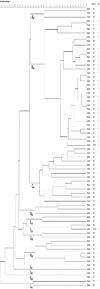A novel pore-forming toxin in type A Clostridium perfringens is associated with both fatal canine hemorrhagic gastroenteritis and fatal foal necrotizing enterocolitis
- PMID: 25853427
- PMCID: PMC4390311
- DOI: 10.1371/journal.pone.0122684
A novel pore-forming toxin in type A Clostridium perfringens is associated with both fatal canine hemorrhagic gastroenteritis and fatal foal necrotizing enterocolitis
Abstract
A role for type A Clostridium perfringens in acute hemorrhagic and necrotizing gastroenteritis in dogs and in necrotizing enterocolitis of neonatal foals has long been suspected but incompletely characterized. The supernatants of an isolate made from a dog and from a foal that died from these diseases were both found to be highly cytotoxic for an equine ovarian (EO) cell line. Partial genome sequencing of the canine isolate revealed three novel putative toxin genes encoding proteins related to the pore-forming Leukocidin/Hemolysin Superfamily; these were designated netE, netF, and netG. netE and netF were located on one large conjugative plasmid, and netG was located with a cpe enterotoxin gene on a second large conjugative plasmid. Mutation and complementation showed that only netF was associated with the cytotoxicity. Although netE and netG were not associated with cytotoxicity, immunoblotting with specific antisera showed these proteins to be expressed in vitro. There was a highly significant association between the presence of netF with type A strains isolated from cases of canine acute hemorrhagic gastroenteritis and foal necrotizing enterocolitis. netE and netF were found in all cytotoxic isolates, as was cpe, but netG was less consistently present. Pulsed-field gel electrophoresis showed that netF-positive isolates belonged to a clonal population; some canine and equine netF-positive isolates were genetically indistinguishable. Equine antisera to recombinant Net proteins showed that only antiserum to rNetF had high supernatant cytotoxin neutralizing activity. The identifica-tion of this novel necrotizing toxin is an important advance in understanding the virulence of type A C. perfringens in specific enteric disease of animals.
Conflict of interest statement
Figures






References
Publication types
MeSH terms
Substances
LinkOut - more resources
Full Text Sources
Other Literature Sources
Medical
Molecular Biology Databases
Research Materials
Miscellaneous

